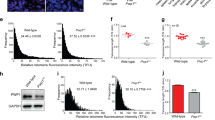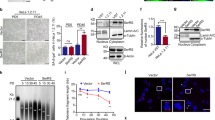Abstract
Telomere uncap** is thought to be the fundamental cause of replicative cellular senescence, but the cellular machineries mediating this process have not been fully understood. In the present study, we present the role of Sp1 transcription factor in the state of telomere uncap** using the TRF2ΔBΔM-induced senescence model in human diploid fibroblasts. We observed that the expression of Sp1 is down-regulated in the TRF2ΔBΔM-induced senescence, which was mediated by ATM and p38 MAPK. In addition, overexpression of Sp1 prevented the TRF2ΔBΔM-induced senescence. Among transcriptional targets of Sp1, expression levels of nuclear transport genes such as karyopherin α, Nup107, and Nup50 were down-regulated in the TRF2ΔBΔM-induced senescence, which was prevented by Sp1 overexpression. Moreover, inhibition of the nuclear transport by wheat germ agglutinin (an import inhibitor) and leptomycin B (an export inhibitor) induced premature senescence. These results suggest that Sp1 is an anti-senescence transcription factor in the telomere uncap**-induced senescence and that down-regulation of Sp1 leads to the senescence via down-regulation of the nuclear transport.






Similar content being viewed by others
Abbreviations
- ATM:
-
Ataxia telangiectasia mutated
- HDF:
-
Human diploid fibroblast
- MAPK:
-
Mitogen-activated protein kinase
- Sp1:
-
Specificity protein 1
- TRF2:
-
Telomeric repeat-binding factor 2
References
Blackburn EH (2001) Switching and signaling at the telomere. Cell 106:661–673
de Lange T (2009) How telomeres solve the end-protection problem. Science 326:948–952
d’Adda di Fagagna F, Reaper PM, Clay-Farrace L, Fiegler H, Carr P, Von Zglinicki T, Saretzki G, Carter NP, Jackson SP (2003) A DNA damage checkpoint response in telomere-initiated senescence. Nature 426:194–198
Smogorzewska A, de Lange T (2002) Different telomere damage signaling pathways in human and mouse cells. EMBO J 21:4338–4348
van Steensel B, Smogorzewska A, de Lange T (1998) TRF2 protects human telomeres from end-to-end fusions. Cell 92:401–413
Zhang H, Pan KH, Cohen SN (2003) Senescence-specific gene expression fingerprints reveal cell-type-dependent physical clustering of up-regulated chromosomal loci. Proc Natl Acad Sci U S A 100:3251–3256
Wierstra I (2008) Sp1: emerging roles—beyond constitutive activation of TATA-less housekee** genes. Biochem Biophys Res Commun 372:1–13
Kim SY, Kang HT, Han JA, Park SC (2012) The transcription factor Sp1 is responsible for aging-dependent altered nucleocytoplasmic trafficking. Aging Cell 11:1102–1109
Oh JE, Han JA, Hwang ES (2007) Downregulation of transcription factor, Sp1, during cellular senescence. Biochem Biophys Res Commun 353:86–91
Yeo EJ, Hwang YC, Kang CM, Kim IH, Kim DI, Parka JS, Choy HE, Park WY, Park SC (2000) Senescence-like changes induced by hydroxyurea in human diploid fibroblasts. Exp Gerontol 35:553–571
Kim SR, Park JH, Lee ME, Park JS, Park SC, Han JA (2008) Selective COX-2 inhibitors modulate cellular senescence in human dermal fibroblasts in a catalytic activity-independent manner. Mech Ageing Dev 129:706–713
Ory DS, Neugeboren BA, Mulligan RC (1996) A stable human-derived packaging cell line for production of high titer retrovirus/vesicular stomatitis virus G pseudotypes. Proc Natl Acad Sci USA 93:11400–11406
Dimri GP, Lee X, Basile G, Acosta M, Scott G, Roskelley C, Medrano EE, Linskens M, Rubelj I, Pereira-Smith O et al (1995) A biomarker that identifies senescent human cells in culture and in aging skin in vivo. Proc Natl Acad Sci USA 92:9363–9367
Jacobs JJ, de Lange T (2005) p16INK4a as a second effector of the telomere damage pathway. Cell Cycle 4:1364–1368
Park SC (2011) Nuclear barrier hypothesis of aging as mechanism for trade-off growth to survival. Adv Exp Med Biol 720:3–13
Koutsodontis G, Tentes I, Papakosta P, Moustakas A, Kardassis D (2001) Sp1 plays a critical role in the transcriptional activation of the human cyclin-dependent kinase inhibitor p21(WAF1/Cip1) gene by the p53 tumor suppressor protein. J Biol Chem 276:29116–29125
Wu J, Xue L, Weng M, Sun Y, Zhang Z, Wang W, Tong T (2007) Sp1 is essential for p16 expression in human diploid fibroblasts during senescence. PLoS One 2:e164
Ammendola R, Mesuraca M, Russo T, Cimino F (1992) Sp1 DNA binding efficiency is highly reduced in nuclear extracts from aged rat tissues. J Biol Chem 267:17944–17948
Dimri GP, Campisi J (1994) Altered profile of transcription factor-binding activities in senescent human fibroblasts. Exp Cell Res 212:132–140
Kim SY, Kang HT, Han JA, Park SC (2012) The transcription factor Sp1 is responsible for aging-dependent altered nucleocytoplasmic trafficking. Aging Cell 11:1102–1109
D’Angelo MA, Hetzer MW (2008) Structure, dynamics and function of nuclear pore complexes. Trends Cell Biol 18:456–466
Hoelz A, Blobel G (2004) Cell biology: pop** out of the nucleus. Nature 432:815–816
Acknowledgments
This research was supported by the Basic Science Research Program through the NRF funded by the Ministry of Education, Science and Technology (2010-0007188) and by the 2015 Research Grant from Kangwon National University (No. 520150358).
Author information
Authors and Affiliations
Corresponding author
Electronic supplementary material
Below is the link to the electronic supplementary material.
Rights and permissions
About this article
Cite this article
An, H.J., Lee, H.J., Jang, S. et al. Transcription factor Sp1 prevents TRF2ΔBΔM-induced premature senescence in human diploid fibroblasts. Mol Cell Biochem 414, 201–208 (2016). https://doi.org/10.1007/s11010-016-2672-7
Received:
Accepted:
Published:
Issue Date:
DOI: https://doi.org/10.1007/s11010-016-2672-7




